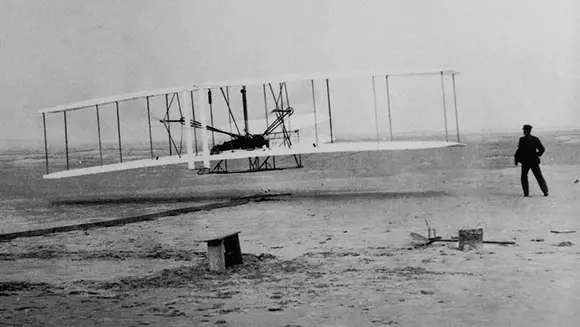
Pic: Nasa
Today marks the 110 th anniversary of Orville Wright's history-making 120ft trip aboard Flyer I near Kill Devil Hill in North Carolina which stands as the record for the first power driven flight.
Despite having no formal engineering training, Orville and his brother Wilbur from Dayton, Ohio designed and built what the U.S. Smithsonian Institution describes as "...the first powered, heavier-than-air machine to achieve controlled, sustained flight with a pilot aboard”.
Maintaining an airspeed of 48 km/h (30 mph), a ground speed of 10.9 km/h (6.8 mph) and an altitude of 2.5 -3.5 m (8 - 12 ft), the short, 12 second journey in 1903 ushered in the era of flight and ensured the Wright Brothers place in the history books.
Observed nationally since 1963 across the US to honour Wilbur and Orville’s achievement, we’re also commemorating Wright Brothers Day here on GuinnessWorldRecords.com today with our pick of aviation records below.
In France, on 13 November 1907, Paul Cornu flew an experimental helicopter in untethered flight for the first time. While it was likely no more than a hop or series of airborne hops, the event is netherlestheless regarded as the first helicopter flight (free flight of a rotary-wing aircraft). Another two machines were built but the control system proved to be ineffective, and no further progress was made with it.
Lieutenant Thomas Etholen Selfridge (USA) was an army observer on a plane piloted by Orville Wright (USA) on 17 September 1908 when four minutes into the performance test of the aircraft 'Wright Flyer' at Fort Myer, Virginia, USA, the propeller snapped a rudder control wire, which forced the propeller to break and lead to the plane nose diving into a field. Selfridge died from his internal injuries and fractured skull within three hours of the accident, making it the first fatal aeroplane crash. Wright was hospitalized with a fractured thigh and several broken ribs.
The first airmail flight was made by Frenchman Henri Pequet on 18 February 1911, only seven years after the Wright brothers made the first ever powered flight. Pequet, flying a small biplane, took 6,500 letters and cards from an airfield in Allahabad, near Delhi, to Naini, 10 kilometres away, in a flight lasting about 15 minutes. On 12 February 2011, coinciding with the opening of the World Philatelic Exhibition in New Delhi, the Indian government marked the event’s centenary by re-enacting Pequet’s historic flight.
The world’s first flight attendant was Heinrich Kubis (Germany), who began attending to passengers on board the DELAG Zeppelin LZ-10 Schwaben in March 1912. Kubis initially worked on the flights alone but was later supported by an assistant steward on board the 20-passenger LZ-127 Graf Zeppelin. He also took the role of chief steward on the famous 72-passenger LZ-129 Hindenburg, where he led a team of male stewards, and was on board when it burst into flames at Lakehurst in New Jersey, USA, on 6 May 1937; he escaped with his life by jumping out of the window as the cabin neared the ground.
The first in-flight movie was First National’s The Lost World (USA, 1925), shown during an Imperial Airways flight in a converted Handley-Page bomber, from London, UK, to Paris, France, in April 1925.
Wiley Post (USA) made the first solo flight around the world from 15 to 22 July 1933 in a Lockheed Vega called Winnie Mae. He covered 25,110 km (15,596 miles) in just 7 days 18 hr 49 min. The plane was fitted with new technology of the day such as an automatic pilot.
The 36-seat British De Havilland Comet was the first jet-powered commercial aircraft. It was powered by four De Havilland Ghost 50 engines mounted within its wings and took its first flight in 1949. Its first scheduled passenger-carrying flight was also the first jet passenger service, between London, UK, and Johannesburg, South Africa, on 2 May 1952, operated by BOAC. On 4 October 1958, it began the ´irst transatlantic jet service between the UK and the USA, also operated by BOAC.
In 1956, Dr David Warren (Australia) designed a crash-survivable prototype called the ARL Flight Memory Unit to record a flight crew’s conversation and other data prior to a crash – now recognised as the first black box aircraft data recorder. Dr Warren was working at the Defence and Science Technological Organization’s Aeronautical Research Laboratories in Melbourne, Australia. His interest in electronics was prompted by his father giving him a crystal radio set in 1934 when he was nine. Shortly afterwards, his father was killed in one of Australia’s first air disasters, the loss of the de Havilland 86 Miss Hobart in the Bass Strait south of Victoria, between Australia and Tasmania.
The first ever supersonic flight was achieved on 14 October 1947 by Captain (later Brigadier General) Charles `Chuck' Elwood Yeager (USA), over Lake Muroc, California, USA, in a Bell XS-1 rocket aircraft. Yeager reached Mach 1.015 (1078 km/h 670 mph) at an altitude of 12,800 m (42,000 ft). The XS-1 now resides in the Smithsonian Institution, Washington, DC, USA.
Col. Clarence Cornish (1898-95) of Indianapolis, Indiana, USA, piloted planes from on 6 May 1918 (first solo flight was 21 days later) until 4 December 1995, a total of 77 years 212 days, earning him the world record for longest career as a pilot. He died 18 days after his last flight.
